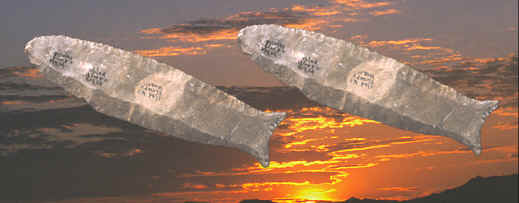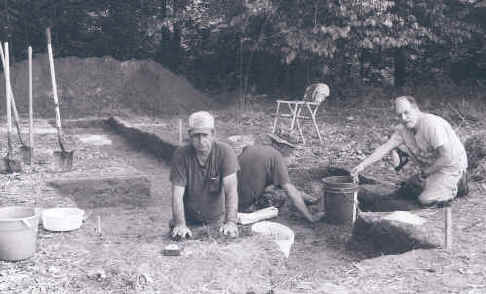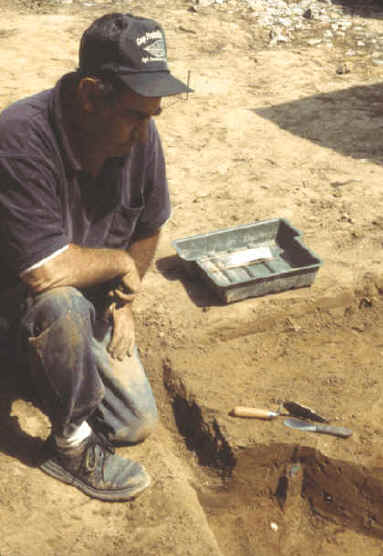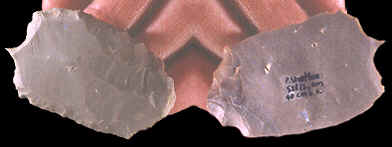|

|
|
abstract
THE PHIL STRATTON SITE
A PALEO-INDIAN CUMBERLAND SITE
LOGAN COUNTY, KENTUCKY
The first investigation of the Phil Stratton site began in 1999
under the direction of Richard Michael Gramly, PhD. and the project
is still ongoing. This site is located on a bluff above the Red
River in Logan County in southwestern Kentucky. The Phil
Stratton site dates to the Paleo-Indian period. A Cumberland /
Barnes component is buried 30 to 40 cm beneath a layer of
undisturbed loess. Two hundred Cumberland / Barnes related tools
have been discovered to date, including 4 Cumberland points. Of
particular interest is the fact that only one "normal"
end-scraper has been found. Unlike Clovis sites where end-scrapers
are commonly found, the most common tool form discovered so far on
the Phil Stratton site, with the exception of utilized flakes, are side-scrapers made from core blades.
|
|
|
"---we are uncertain if Cumberland / Barnes is older, younger or
the same age as Clovis, /Crowfield, Folsom, etc."---Archaeological
Investigations of the Phil Stratton Site, 1999-2004: A Component of the
Cumberland / Barnes Tradition.
"Since both
Cumberland and Barnes types are present in Kentucky and Tennessee--but
only Barnes points (are found) farther north in the formerly glaciated
great Lakes region--one is inclined to believe that evolution from one
form to the other occurred within the Cumberland "core area" of the
mid-South."---2005,
Richard Michael Gramly, Archaeological Investigations of the Phil
Stratton Site, 1999-2004: A Component of the Cumberland / Barnes
Tradition.

PHIL STRATTON CUMBERLAND SITE
LOGAN COUNTY, KENTUCKY
The Phil Stratton site is located in Logan County, in southwestern
Kentucky. It is situated on top of a bluff above the meandering Red
River. At present, the Phil Stratton site is the only deeply
buried undisturbed Cumberland site under excavation. If fact, it
appears to be the only intact undisturbed single-component Cumberland
site so far excavated to date. The site was discovered by Phil Stratton
when expanding a driveway to a greenhouse.
|
|

PHOTO
CREDIT RICHARD M. GRAMLY
CLICK ON
PICTURE FOR LARGER IMAGE
EXCAVATIONS AT THE PHIL
STRATTON SITE, 2003
PHIL STRATTON CUMBERLAND
SITE
LOGAN COUNTY, KENTUCKY
This picture shows the excavation in progress on the Phil Stratton
Cumberland site in 2003. The Cumberland component is buried
beneath 12 to 16 inches (30 to 40 cm) of an undisturbed layer of loess. Approximately 50 2-meter
squares have been excavated since 1999. |
|
|
Mike Gramly is the research investigator in charge of
the Phil Stratton site. He writes that "Despite over 40 years of archaeological
research, neither Cumberland nor Barnes points have been dated by
absolute means (radiocarbon, etc.) to the satisfaction of most
archaeologists" (Gramly,
Richard M., 2005). The best
estimates for the age of Cumberland or Barnes points have come from a
Cumberland point found in association with caribou bones at the Dutchess
Quarry Cave #1 site in eastern New York. A radiocarbon test of bone
collagen produced a date of 12,530 +/- 370 years.
|
|

PHOTO CREDIT
RICHARD M. GRAMLY
PHIL STRATTON CONTEMPLATING
NEW FIND
PHIL STRATTON CUMBERLAND
SITE
LOGAN COUNTY, KENTUCKY
Phil Stratton pauses at unit S8E12 while a picture is taken of a,
just discovered, basal fragment of a Cumberland point. Four
Cumberland points have been found on the Phil Stratton site since
1999. |
|
|
The Phil Stratton site is situated at a location
where there is a ford across the Red River. This geological formation
may have been an opportune place to intercept game when Cumberland
people were camping there. Paleo-Indian sites were often located on
elevated sites where game animals could be observed moving nearby across
waterways or valleys.
|
|
CONTINUE ON TO PAGE
TWO
|
|
"REFERENCES"
1985,
Gregory Perino, "Selected Preforms, Points and Knives of the North
American Indians, Vol. 1," p. 94.
2005,
Richard Michael Gramly, "Archaeological Investigations of the Phil
Stratton site, 1999-2004: A component of the Cumberland / Barnes
tradition," The Amateur Archaeologist, pp. 39-60.
Personal communications with Mike Gramly.
|
|
RECENT
LISTINGS HOME
ORDERING |





